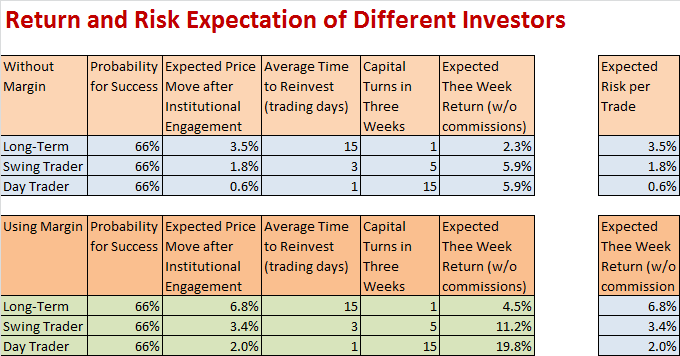Many private
traders like the exciting environment of trading the financial markets. Trading
can be a wonderful hobby. For hobbies, we like to spend money and this is
usually what happens; however, if you want to take trading and investing serious,
you need to start being a probability thinker: Understanding how probable it is
for you in a string of investments to make money following clearly defined
trading or investing guidelines.
What are your
odds of making money?
Before we
help you to answer this question, let us reiterate some prerequisites of
trading success:
- Have a system.
- Be disciplines and follow the system.
- Trade only, when the odds are in your favor
Example: NeverLossTrading Top Line Chart for FAS
At this NeverLossTrading
example, you only trade when the price development of the candle following the
trade initiation candle (situations marked with numbers) surpasses the spelled
out price threshold: Buy>$101.10 for example. Summary: The price of the next
candle has to move higher to validate the entry proposal. The trade target is
pre-calculated and either marked with a dot on the chart or by a horizontal NLT
Price Gravitation Line. The red line on the chart: NLT Double Decker Line
allows for trailing your stop.
To calculate
or evaluate the odds of the trade situation, we run a quick appraisal for the
three trade situations, which all have a high probability trade setup at the
chart constellation:
Situation-1: Risky, by having a substantially
higher risk than reward: Stop at the high of the candle.
Situaiton-2: Favorable setup. Stop at the low of
the candle, with a higher reward than risk.
Situaiton-3: Favorable setup. Stop at the low of
the candle, with a higher reward than risk.
However, if
your trading system does not portrait entries, exits, and stops, what do you
do?
A simple way
of calculating the odds of a trade setup is:
Probability
of the Trade Setup (past performance) x Reward / (Risk x Probability of
Failing)
At this
point, note the Golden Rule of Trading Success:
The
factor of this calculation shall be above 1.5-points.
Example-1: Probability for success of the trade
setup (from history): 65%, with a risk of $1 and a reward of $1. The calculated
factor comes to 1.94; thus, it is above 1.5 and tells you that you found a
trade setup where the odds in your favor according to our Golden Rule.
Example-2: Probability for the trade setup: 58%,
with a risk of $1 and a reward of $1. The calculated factor comes to 1.38 and
is below 1.5 telling you that the odds of the trade setup evaluated are NOT in
your favor.
When it is
that easy, why do most private investors fail to achieve their financial goals?
Our answer:
Most private investors or traders use trading systems, which are either random
or produce a probability for success between 53% - 57% where the factor <
1.5. Examples are:
- Moving average based indicators: MACD, Bollinger Bands, RSI, CCI...
- Candle setups: Doji, Harami, Hangman…
- Long-term patterns: Head and Shoulder, Cup and Handle…
We tested and
programmed all of those setups and many others. For traders who sign up for our
program, we always offer to parallel-program the trade situation, you based
your decision on and then we compare.
In addition, most
standard indicators are lagging and propose entries when the major price move
is close to over; providing you a trade-setup where the risk is mostly higher
than the reward; bringing you into a circle-of-doom-pattern: Small gain, small gain, big loss.
This is where
NeverLossTrading systems make a difference.
1.
You
trade at major swing points of institutional
supply and demand shifts.
E-Mini
S&P 500 Daily Chart with NLT Top-Line Indicators
2.
By
the support of calculation tables, you get your trade situation appraised, calculating
the likelihood for success, potential risk and reward, with a proposal for the
position sizing.
NeverLossTrading Evaluation
Model
3.
Critical
for the private investor is to know about trading opportunities. Choosing from
40,000 US-traded stocks is not easy. With NeverLossTrading, you can always stay
engaged in the market, by either scanning the for favorable trade setups, using
NLT Top-Line integrated market scanners or by subscribing to the NLT Alerts
(free for three months with a mentorship).
Scan
for Your Trading Opportunities or Subscribe to our NLT Alert Service
In the NeverLossTrading
Mentorship, you further experience:
- Individual training units, fit to your personal wants and needs (all recorded)
- 200-page documentation for easy access to key information.
- Six month of mentorship with trade feedback and further education.
- All software installed for you. The license fee paid off with the initial tuition.
- Real time data on a server based programming, available from every computer.
- Data feed from a free platform with no need to change your broker relationships.
- ...
All for helping you to
develop yourself into the trader, you want to be!
Several
NeverLossTrading Mentorships are offered, which support Day Traders, Swing
Traders, and Long-Term Investors.
Take the
chance and test us live. Schedule a free consulting hour, where we get together
online with you, share our screens and answer your questions:
Call: +1 866 455 4520
In case you
are not yet subscribed to our free trading tips and market reports, sign up
here:
Please always
consider the risk of trading and that past performance cannot be taken
indicative for future results.
Good trading,
Thomas













